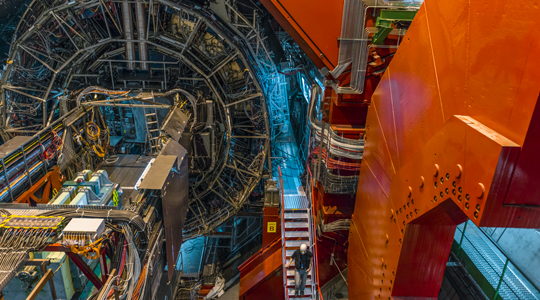 The ALICE experiment at the Large hadron collider (LHC) at CERN has observed for the first time in collisions between protons an increase in the production of so-called strange particles, which is one of the distinguishing phenomena of quark-gluon plasma, a very hot and dense state of matter which existed just a few millionths of a second after the Big Bang. So far, this characteristic of the state of primordial matter had only been observed in collisions between heavy nuclei, and nobody thought that it could also be found in proton collisions. This unexpected observation is a challenge to existing theoretical models, which do not include the increase of strange particles in these events. The result, published in Nature Physics on April 24
The ALICE experiment at the Large hadron collider (LHC) at CERN has observed for the first time in collisions between protons an increase in the production of so-called strange particles, which is one of the distinguishing phenomena of quark-gluon plasma, a very hot and dense state of matter which existed just a few millionths of a second after the Big Bang. So far, this characteristic of the state of primordial matter had only been observed in collisions between heavy nuclei, and nobody thought that it could also be found in proton collisions. This unexpected observation is a challenge to existing theoretical models, which do not include the increase of strange particles in these events. The result, published in Nature Physics on April 24
th, was obtained from the analysis of data on collisions with 7 TeV protons on Run 1 of the LHC, and is based on the observation of the strange hadrons in proton-proton collisions in which a large number of particles is produced. Strange hadrons are well known particles, called like this because they are made of quarks, of which at least one is a strange quark. The strange quarks are heavier than quarks that make up “normal" matter and are difficult to produce. But this changes when we are in the presence of a high energy density, which rebalances the creation of strange quarks in relation to the non-strange ones, just like in heavy ion collisions. The new results show that, in the studied proton-proton collisions, the rate of production of strange hadrons increases with the 'multiplicity' (the number of particles produced in a given collision) faster than what happens for
the other species of particles generated in the same collision. The data also show that the higher the number of strange quarks contained in the produced hadron, the greater the increase of its production speed. However, no dependence on the collision energy or the mass of particles generated is observed, demonstrating that the observed phenomenon is related to the fact that the particles produced contain strange quarks. The more precise study of these processes will be the key to understand more thoroughly the microscopic mechanisms of the quark-gluon plasma and the collective behaviour of the
particles in small systems.






